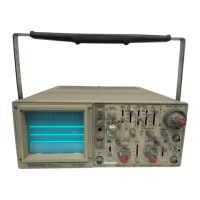Fig.
32
[EXAMPLE]
In the example, the A
SWEEP
TIME is 2 fis and the B
SWEEP
TIME is 0.2 fis. (See Fig. 32)
Substituting the given value:
2x 10~
6
Apparent magnification ratio = = 10
0.2 x 10"
6
With
the above magnification, if the magnification ratio is
increased,
delay
jitter
will occur.
To
achieve a stable display, set the B MODE to TRIG and
used
the triggered mode of operation.
1.
Perform the above steps 1 through 3.
2.
Set the B TRIG MODE to
TRIG.
3.
Set the HORIZ MODE to either ALT or B. The apparent
magnification will be the same as described above.
DELAYED
SWEEP TIME MEASUREMENT
Using
the B sweep, high accuracy
time
measurements can
be made.
1.
Apply a signal to INPUT jack and set the vertical MODE
to the channel to be
used.
Adjust the VOLTS/DIV and
the other controls if
necessary
to obtain an easily
observed
waveform display.
Set
the
SWEEP
VARIABLE
to CAL position.
2.
Adjust the A
SWEEP
TIME/DIV to display the portion of
waveform to be measured. Set the B TRIG MODE to
AFTER
DELAY
mode.
Set
the HORIZ MODE to INT and adjust the B
SWEEP
TIME/DIV for as small as possible an intensified region.
3.
Using the • POSITION control adjust the waveform
position so as to intersect
with
the center horizontal line
on the CRT
screen.
Use the
DELAY
TIME MULT so
that
the intensified portion of waveform touches the center
horizontal line and record the settng of the
DELAY
TIME
MULT at this point.
4. Use the
DELAY
TIME MULT to adjust intensified portion
to same point of the second waveform.
The
waveform period is the second dial reading minus
the first dial reading multiplied by the A
SWEEP
TIME/DIV setting.
Using
the formula:
Period
= (2nd dial reading —1st dial reading)
x Delayed sweep
time
(A
SWEEP
TIME/DIV setting)
Delay time
[EXAMPLE]
For
the example the first dial setting is 1.01 and the second
is
6.04. The setting of A
SWEEP
TIME/DIV is 2 ms. (See
Fig.
33)
Substituting the given value:
Period
= (6.04
-1.01)
x 2 (ms) = 10.06 ms
PULSE WIDTH MEASUREMENTS
USING
DELAYED
SWEEP
This
method is similar to the
time
measurement method
and can be used for high accuracy pulse
width
measurements.
1.
Apply the pulse signal to the INPUT jack and set the ver-
tical MODE to the channel to be
used.
2.
Use the VOLTS/DIV,
VARIABLE
and w POSITION
con-
trols to adjust the display
such
that
the waveform is
easily
observable
with
the center of the pulse
width
coinciding
with
the center horizontal graduation line.
Set
the
SWEEP
VARIABLE
to CAL position.
3.
Set the A
SWEEP
TIME/DIV to display the portion of the
waveform to be measured, set the B TRIG MODE to
TRIG.
Set
the HORIZ MODE to INT, and adjust the B
SWEEP
TIME/DIV for as short as possible an intensified section
of waveform.
4. Using the
DELAY
TIME MULT, adjust the display so
that
the intensified portion touches the center horizontal
graduation line of the CRT
screen
and record the dial
setting at this point.
5. Using the
DELAY
TIME MULT adjust the falling edge of
the pulse so
that
it touches the center horizontal gradua-
tion
line and is intensified.
The
pulse
width
is the second dial reading minus the first
dial reading multiplied by the A
SWEEP
TIME/DIV
set-
ting.
Using
the formula:
Pulse
width
= (2nd dial reading-1st dial reading)
x Delayed sweep
time
(A
SWEEP
TIME/DIV setting)
27
Intensity
modulation
area
A Sweep
B
Sweep
Fig.
33

